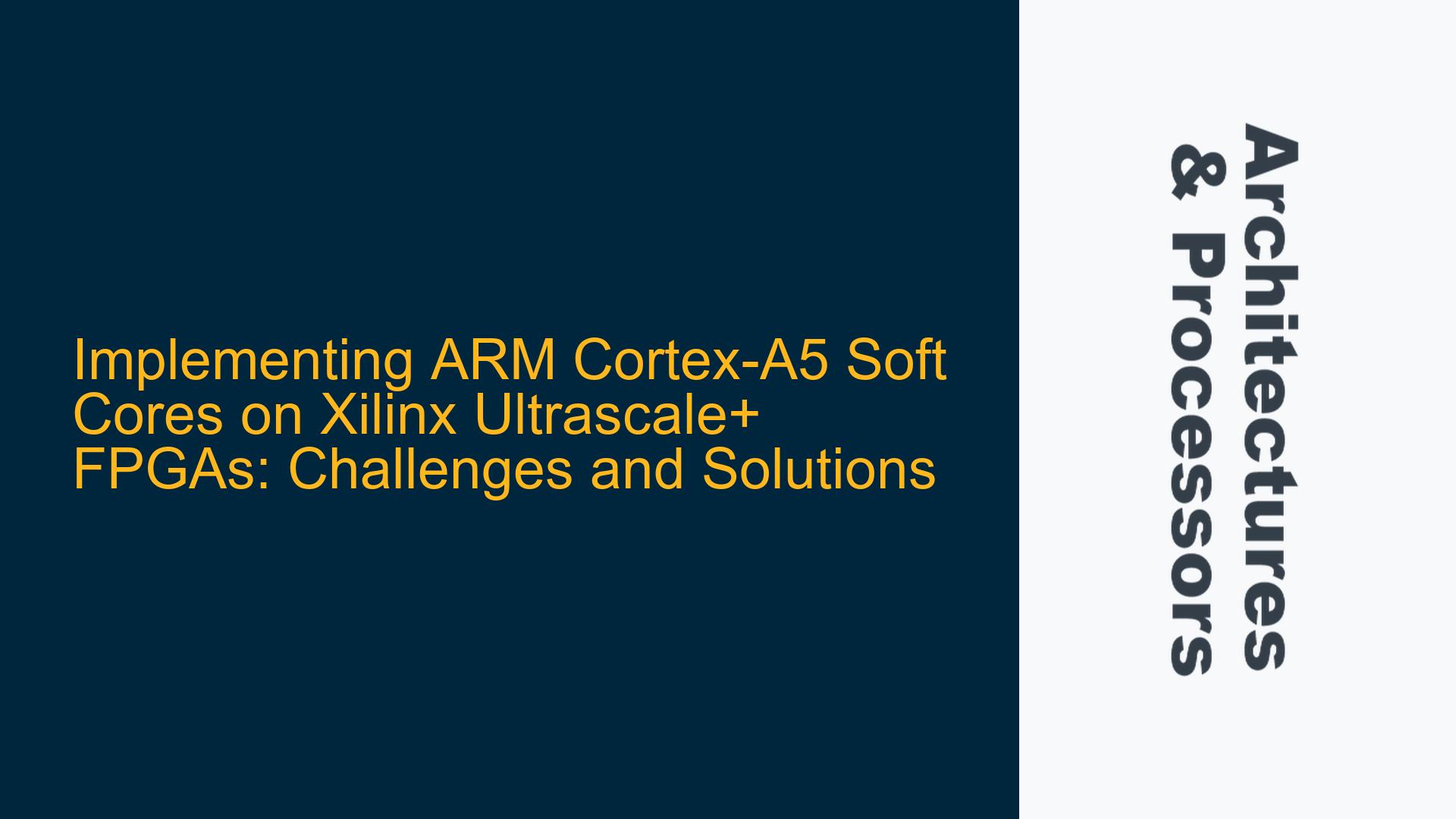ARM Cortex-A5 Soft Core Availability for Xilinx Ultrascale+ FPGAs
The integration of ARM Cortex-A5 soft cores into Xilinx Ultrascale+ FPGAs presents a unique set of challenges and opportunities for embedded systems engineers. The Cortex-A5, being a member of the ARM Cortex-A family, is designed for high-performance applications, making it an attractive option for FPGA-based designs. However, unlike the Cortex-M1 and Cortex-M3, which are readily available as soft IP cores for Xilinx FPGAs, the Cortex-A5 is not as easily accessible in a soft core format. This discrepancy raises several questions about the feasibility and methodology of implementing Cortex-A5 soft cores on Xilinx Ultrascale+ devices.
The Cortex-A5 is a 32-bit RISC processor that supports the ARMv7-A architecture, offering features such as a superscalar pipeline, out-of-order execution, and advanced power management. These features make it suitable for applications requiring high computational power, such as automotive systems, industrial automation, and consumer electronics. However, the complexity of the Cortex-A5 architecture, combined with the resource constraints of FPGAs, makes it challenging to implement as a soft core.
Xilinx Ultrascale+ FPGAs, on the other hand, are known for their high logic density, advanced DSP capabilities, and integrated hard IP blocks, making them ideal for complex system-on-chip (SoC) designs. The combination of Cortex-A5 soft cores with Ultrascale+ FPGAs could enable the development of highly customized, high-performance embedded systems. However, the lack of readily available Cortex-A5 soft cores for Xilinx FPGAs necessitates a deeper exploration of the underlying issues and potential solutions.
Licensing Constraints and ARM DesignStart Program Limitations
One of the primary reasons for the limited availability of Cortex-A5 soft cores for Xilinx FPGAs is the licensing model employed by ARM. ARM offers its Cortex-M1 and Cortex-M3 cores as part of its DesignStart program, which provides free access to these cores for FPGA implementation. However, the Cortex-A5 is not included in this program, making it more difficult for developers to obtain the necessary IP for FPGA-based designs.
The ARM DesignStart program is designed to lower the barrier to entry for developers looking to implement ARM cores in their designs. By offering free access to Cortex-M1 and Cortex-M3 cores, ARM enables developers to experiment with and prototype their designs on FPGAs without incurring significant licensing costs. However, the Cortex-A5, being a more complex and high-performance core, is not part of this program. This limitation is likely due to the higher value and more stringent licensing requirements associated with the Cortex-A series.
The absence of Cortex-A5 soft cores in the DesignStart program means that developers must seek alternative avenues to obtain the necessary IP. One such avenue is the ARM DesignStart FPGA bundle, which includes a Cortex-A5 DesignStart package for the MPS3 development board. The MPS3 board is equipped with a Xilinx Kintex Ultrascale KU115 FPGA, providing a platform for firmware and software development. However, this bundle is limited to the MPS3 board and does not provide the necessary files for implementing the Cortex-A5 core on custom Xilinx FPGA designs.
The lack of a comprehensive solution for implementing Cortex-A5 soft cores on Xilinx FPGAs highlights the need for a more flexible licensing model that accommodates the needs of developers working on custom FPGA-based designs. Until such a model is available, developers must rely on alternative approaches, such as using the MPS3 board for initial development and then porting their designs to custom FPGA implementations.
Strategies for Implementing Cortex-A5 Soft Cores on Xilinx Ultrascale+ FPGAs
Despite the challenges associated with implementing Cortex-A5 soft cores on Xilinx Ultrascale+ FPGAs, there are several strategies that developers can employ to achieve their design goals. These strategies include leveraging existing FPGA bundles, exploring third-party IP providers, and considering alternative ARM cores that may be more readily available for FPGA implementation.
The ARM DesignStart FPGA bundle, while limited to the MPS3 development board, provides a starting point for developers looking to work with Cortex-A5 cores. By using the MPS3 board for initial development, developers can gain valuable experience with the Cortex-A5 architecture and develop the necessary firmware and software components. Once the initial development is complete, developers can explore options for porting their designs to custom Xilinx FPGA implementations. This process may involve reverse-engineering the bitstream files provided with the MPS3 bundle or working with ARM to obtain the necessary IP for custom FPGA designs.
Another approach is to explore third-party IP providers that offer Cortex-A5 soft cores for Xilinx FPGAs. While ARM may not provide direct access to Cortex-A5 soft cores, there are third-party vendors that specialize in developing and licensing ARM-compatible IP for FPGA implementation. These vendors may offer more flexible licensing terms and provide the necessary support for integrating Cortex-A5 cores into custom FPGA designs. However, developers must carefully evaluate the quality and compatibility of third-party IP to ensure that it meets their design requirements.
Finally, developers may consider alternative ARM cores that are more readily available for FPGA implementation. While the Cortex-A5 offers a unique combination of performance and features, other ARM cores, such as the Cortex-M7 or Cortex-R5, may provide a suitable alternative for certain applications. These cores are available as part of the ARM DesignStart program and can be implemented on Xilinx FPGAs with relative ease. By carefully evaluating the specific requirements of their application, developers can determine whether an alternative ARM core may be a viable option.
In conclusion, implementing ARM Cortex-A5 soft cores on Xilinx Ultrascale+ FPGAs is a complex but achievable goal. By understanding the licensing constraints, leveraging existing FPGA bundles, exploring third-party IP providers, and considering alternative ARM cores, developers can overcome the challenges associated with this task and create high-performance, customized embedded systems. As the demand for FPGA-based designs continues to grow, it is likely that ARM and Xilinx will work together to provide more comprehensive solutions for implementing Cortex-A5 soft cores on Xilinx FPGAs, further enabling the development of innovative embedded systems.






